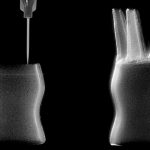 3D printing is a topic I’ve touched upon many times in the past few years, not least in the healthcare field, where its range of applications has grown considerably in recent months. These were highlighted in a recent paper from the University of Melbourne.
3D printing is a topic I’ve touched upon many times in the past few years, not least in the healthcare field, where its range of applications has grown considerably in recent months. These were highlighted in a recent paper from the University of Melbourne.
“At the moment 3D printing is at the cutting edge of medical research, but in the future the technology will be taken for granted by all of us in healthcare,” the authors say.
The paper outlines five core areas that they believe will gain the most from 3D printing in the healthcare industry in the coming years.
- Bioprinting – The printing of human organs is something I’ve touched upon previously in the context of an ‘organ on a chip’ to expedite the medical research process. The Melbourne paper also highlights the possible use of this technology for reducing the need for transplants.
- Multi-functional medicine – Look in the medicine of anyone with a range of conditions and the number of tablets will be tremendous. Managing such a medicinal regime can be hugely complex. The paper argues that 3D printing can help simplify this by merging many pills into one. It highlights how a 3D printed polypill has already been developed that contains three unique drugs for use in patients with diabetes.
- Surgical practice – One of the earliest applications of 3D printing in healthcare was in the production of organ replicas to allow surgeons to practice before an operation. Studies into such use cases show that operations are typically conducted faster and more effectively when surgeons can practice beforehand.
- Customized prosthetics – Whether it’s prosthetic limbs or even medical implants, there is considerable potential for the 3D production of artificial organs. 3D printing provides a cost-effective way of developing customized limbs designed specifically for each patient, thus removing the need to alter bodies to fit the prosthetic, as is still the case with hip replacement operations.
- Localized production – A few years ago I wrote about an MIT initiative to use 3D printing to allow nurses to undertake more technical changes of their own volition and experiment locally. The Melbourne paper makes a similar argument, that 3D printing will allow for production to be localized rather than the centralized system we tend to have today.
Training the industry
The authors argue that the biggest obstacle to overcome before 3D printing can be a mainstream technology in healthcare is ensuring staff are sufficiently skilled in using it. Their clinical experience will be crucial to drive adoption.
“It is a revolutionary technology that will make medical care better and faster, and more personalized. But what we need is for more medical professionals to start exploring and experimenting with what this new technology can do, because many things that we thought of as impossible are now becoming possible,” they say. “I think we are moving towards a world where if you can imagine it, you will be able to print it—so we need to start imagining.”